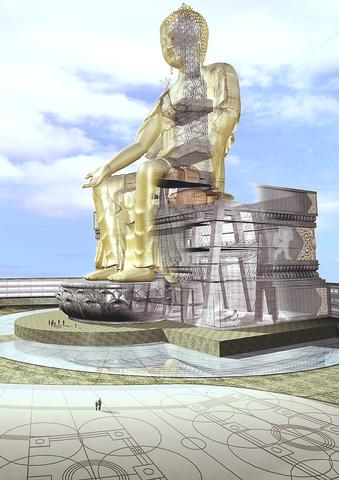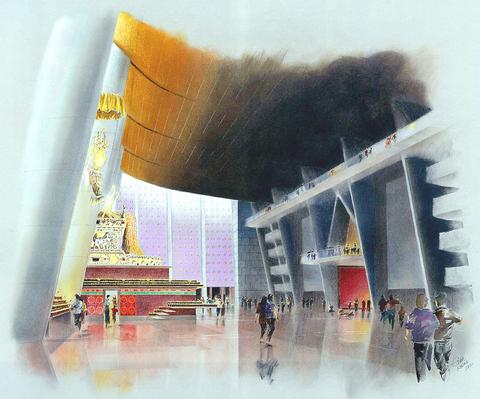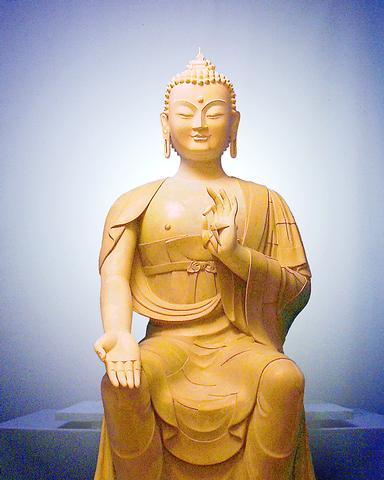It would be difficult to guess that the small office of Maitreya Project International (彌勒大佛工程台灣辦事處), hidden away in the warren of alleys off Nanking East Road Section 4, was an important cog in an international project to build the biggest Buddha statue in the world. Their presence is unremarkable, but their ambition, to erect a statue that will stand 152.4m tall in the town of Bodhgaya, India, is enormous.
Taiwan's participation in the project goes far beyond the country's small size and isolation, being the source of over one third of the funding.
"The largest supply of funds comes from the US," said Peter Kedge, the director of the project, "but Taiwan's contribution has been over 30 percent."

PHOTO COURTESY OF THE MAITREYA PROJECT
"The very idea to make the image so big came from an architect in Taiwan," Kedge said, adding that they settled on the round number of 500 feet (152.4m) during a visit by Lama Thubten Zopa Rinpoche to Taiwan five years ago.
Lama Zopa is the spiritual director of the Foundation for the Preservation of the Mahayana Tradition, a leading sponsor of the Maitreya Project. Since that visit, many Taiwanese have donated money and time to the project. Kedge said Taiwan had played an important role in sustaining Buddhism, in large part because of its considerable financial resources. "From my observation, when Taiwanese make a commitment, they make it with directness."
While declining to name any names, Kedge said that much of the support came from individuals rather than institutions. According to Monica Choying, at an event last November during a visit by Lama Osel, who is believed to be the reincarnation of Lama Yeshe, the initiator of the Maitreya Project, the organizers raised US$100,000 in a single evening.

PHOTO COURTESY OF THE MAITREYA PROJECT
Kedge, an engineer who has worked extensively in the UK and Hong Kong, is one of a growing number of Western Buddhists active around the world in the name of the religion. "Thirty years ago, when I first became interested in Buddhism, you could find perhaps five or six English books on the subject [in bookstores in Nepal]. Now there are thousands of titles available," Kedge said.
He said no definitive figures were available on the number of converts to Buddhism, but pointed to the huge increase in publications as proof at least of growing interest.
For this reason, the Maitreya Project has been careful to avoid associations with any one country or sect within Buddhism. While the inspiration for the project came from Lama Thubten Yehshe, the statue that he proposed is intended to express the qualities of the Maitreya Buddha -- compassion and living kindness -- for people of all sects. Kedge pointed out that, probably for the first time in such a project, much of the artistic work will be carried out by people not of Asian decent. "I am glad we chose British contemporary religious artists," Kedge said, adding that the Buddha would adhere to the traditional proportions, but would not be clearly recognizable as belonging to any specific regional style. The prototype is the creation of Denise Griffin, who began work on the figure in Taiwan in 1997.

PHOTO COURTESY OF THE MAITREYA PROJECT
Despite the use of high technology in many aspects of the project, the construction of such a massive religious image seems to harken back to an earlier age. Kedge agrees. "In ancient times, the skyline was dominated by monuments to religion, but now the essential human qualities that they represented are being overshadowed by the demands of an urban, industrialized lifestyle."
He said he felt some initial hesitation toward the project. "Initially I was thinking only about the statue," he said "and something from my Christian upbringing balked at it. ... Gradually, as I have lived with and constantly thought about the project, it has become clear that it is the most brilliantly conceived method to benefit living beings."
Despite its enormous size, the project organizers have decided to cast the statue in bronze, because "it must last for 1,000 years."
Kedge said the statue poses enormous technical challenges. Metallurgist Rudy Hardervijk said that there were few with the technical expertise to create the required large plates of bronze of sufficient structural strength.
Many visits have been made to sites of other monumental statues, including visits with Robert Landsman, the man who had been project manager for the restoration of the Statue of Liberty (46m), and the managers of the Ushiku statue in Tokyo (120m).
Special emphasis has been placed on ensuring the statue helps transform the town of Bodhgaya, a holy site for Buddhists, but which is disintegrating under grinding poverty. According to Choying, some locals had asked why it was necessary to build a statue so far away, rather than in Taiwan, where it would be more convenient to visit and make offerings. Her response was that having the statue built in that holy place would benefit Buddhists all over the world rather than just Taiwanese.
According to Kedge, much of the preliminary work has been completed, and the group aims to complete the whole project by the end of 2005. In a report in The Observer newspaper on May 13, the Chinese government had announced that it would complete a huge Buddha that would stand 2.7m higher than the Bodhgaya statue. Kedge dismissed any idea that there is competition between the Maitraya Project and the Chinese government and simply said that "if we have inspired them to such a project, this should be reason for joy."
To learn more about the Maitreya Project check out http://www.maitreyaproject.org/home/index.html

Oct. 27 to Nov. 2 Over a breakfast of soymilk and fried dough costing less than NT$400, seven officials and engineers agreed on a NT$400 million plan — unaware that it would mark the beginning of Taiwan’s semiconductor empire. It was a cold February morning in 1974. Gathered at the unassuming shop were Economics minister Sun Yun-hsuan (孫運璿), director-general of Transportation and Communications Kao Yu-shu (高玉樹), Industrial Technology Research Institute (ITRI) president Wang Chao-chen (王兆振), Telecommunications Laboratories director Kang Pao-huang (康寶煌), Executive Yuan secretary-general Fei Hua (費驊), director-general of Telecommunications Fang Hsien-chi (方賢齊) and Radio Corporation of America (RCA) Laboratories director Pan
The consensus on the Chinese Nationalist Party (KMT) chair race is that Cheng Li-wun (鄭麗文) ran a populist, ideological back-to-basics campaign and soundly defeated former Taipei mayor Hau Lung-bin (郝龍斌), the candidate backed by the big institutional players. Cheng tapped into a wave of popular enthusiasm within the KMT, while the institutional players’ get-out-the-vote abilities fell flat, suggesting their power has weakened significantly. Yet, a closer look at the race paints a more complicated picture, raising questions about some analysts’ conclusions, including my own. TURNOUT Here is a surprising statistic: Turnout was 130,678, or 39.46 percent of the 331,145 eligible party

The classic warmth of a good old-fashioned izakaya beckons you in, all cozy nooks and dark wood finishes, as tables order a third round and waiters sling tapas-sized bites and assorted — sometimes unidentifiable — skewered meats. But there’s a romantic hush about this Ximending (西門町) hotspot, with cocktails savored, plating elegant and never rushed and daters and diners lit by candlelight and chandelier. Each chair is mismatched and the assorted tables appear to be the fanciest picks from a nearby flea market. A naked sewing mannequin stands in a dimly lit corner, adorned with antique mirrors and draped foliage

The election of Cheng Li-wun (鄭麗文) as chair of the Chinese Nationalist Party (KMT) marked a triumphant return of pride in the “Chinese” in the party name. Cheng wants Taiwanese to be proud to call themselves Chinese again. The unambiguous winner was a return to the KMT ideology that formed in the early 2000s under then chairman Lien Chan (連戰) and president Ma Ying-jeou (馬英九) put into practice as far as he could, until ultimately thwarted by hundreds of thousands of protestors thronging the streets in what became known as the Sunflower movement in 2014. Cheng is an unambiguous Chinese ethnonationalist,